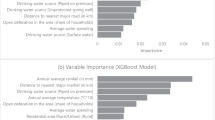Abstract
The 95th percentile of numbers of intestinal enterococci per 100 mL, associated with estimated health risk, is used for determination of the microbial assessment category (MAC) in the National Guidelines for Managing Risks in Recreational Water published by the Australian National Health and Medical Research Council in 2008. A statistical decision support tool was developed to facilitate the analysis of microbial water quality data for the purposes of classifying recreational waterways in south-east Queensland, Australia. This analysis tool, named ‘EnterosisA’, classifies MACs based on an assessment criterion which takes account of both the calculated 95th enterococci percentile values from empirical data and the associated gastrointestinal illness risk. EnterosisA provides similar functionality to the widely used analysis tool ‘Enterotester’, but is distinguished by a completely different procedure for raw data treatment and by its assessment algorithm. Using enterococci data collected from 88 recreational water sites over the period 2010–2013, the MAC assessment results were compared between Enterotester and EnterosisA. The comparison showed that EnterosisA matched Enterotester MAC results in 86.3 % cases, with 11.4 % over-categorized (over-categorization equates to higher levels of estimated health risk) and 2.3 % under-categorized cases. EnterosisA followed a conservative approach to allocate MACs and aimed to minimize the need for user’s intervention in obtaining the assessment results. Without the involvement of hypothesis testing in the assessment procedure and with a one-click-for-answer design, the EnterosisA is much easier to use. Measured in the raw concentration data scale instead of the standardized distribution scale, the trigger levels estimated by EnterosisA are assumed to be more relevant for recreational water management decision making. The EnterosisA is shown to be a valid, alternative analysis tool in the implementation of the recreational water management guidelines through classifying the microbial water quality of water bodies. This research provides valuable empirical evidence for future revisions of the guidelines.




Similar content being viewed by others
References
ABS (2013) National regional profile 2007–2011. Australian Bureau of Statistics. http://ausstats.abs.gov.au/ausstats/nrpmaps.nsf/NEW+GmapPages/national+regional+profile. Accessed 11 Oct 2013
Antweiler RC, Taylor HE (2008) Evaluation of statistical treatments of left-censored environmental data using coincident uncensored data sets: I. Summary statistics. Environ Sci Technol 42:3732–3738
Casella G, Berger RL (2002) Statistical inference, 2nd edn. Duxbury Thomson Learning, Pacific Grove
Environmental Protection Agency, EPA (2006) Data quality assessment: statistical methods for practitioners, EPA QA/G-9S. Environmental Protection Agency, Washington, DC
Glass DC, Gary CN (2001) Estimating mean exposures from censored data: exposure to Benzene in the Australian petroleum industry. Ann Occup Hyg 45(4):275–282
Greene WH (2011) Econometric analysis, 7th edn. Prentice Hall, New York
Hewett P, Ganser GH (2007) A comparison of several methods for analysing censored data. Ann Occup Hyg 51(7):611–632. doi:10.1093/annhyg/mem045
Kay D, Bartram J, Prüss A, Ashbolt N, Wyer MD, Fleisher JM, Fewtrell L, Rogers A, Rees G (2004) Derivation of numerical values for the World Health Organization guidelines for recreational waters. Water Res 38:1296–1304
Lugg RSW, Cook A, Devine B (2012) Estimating 95th percentiles from microbial sampling: a novel approach to standardising their application to recreational waters. In: Kay D, Fricker C (eds) The significance of faecal indicators in water: a global perspective. RSC Publishing, London, pp 62–71. doi:10.1039/9781849735421-00062
NHMRC (2008) National guidelines for managing risks in recreational water. National Health and Medical Research Council, Australian Government Publishing Service, Canberra, Chapter 5 and Appendices 2, 3, and 6
R Core Team (2012) R: a language and environment for statistical computing. R Foundation for Statistical Computing, Vienna. http://www.R-project.org. Accessed 10 May 2012
UWA (2007) Microbial quality of recreational water guidance notes in support of Chapter 5 of NHMRC guidelines for managing risks in recreational waters 2006. Department of Health, Western Australia and The University of Western Australia
Webb G (2011) Recreational water quality monitoring at popular beaches, lakes and rivers in south-east Queensland. Environmental Technical Report, No. 52. Waterways Scientific Services Branch, Queensland Environmental Protection Agency. Retrieved 15 July 2013
WHO (2003) Guidelines for safe recreational water environments: volume 1. Coastal and fresh waters, addendum (2009). World Health Organization, Geneva
Wyer MD, Kay D, Fleisher JM, Salmon RL, Jones F, Godfree AF, Jackson G, Rogers A (1999) An experimental health-related classification for marine waters. Water Res 33(3):715–722
Acknowledgments
This article is part of the research results of the Healthy Waterplay Program sponsored by Healthy Waterways, Brisbane, Australia. Brisbane City Council, City of Gold Coast, Moreton Bay Regional Council and Sunshine Coast Council are stakeholder parties of the Healthy Waterplay Program. The involvement and provision of the datasets used in this research by the officers from these four local councils are kindly acknowledged.
Author information
Authors and Affiliations
Corresponding author
Rights and permissions
About this article
Cite this article
Xie, G., Mengersen, K., Cleary, A. et al. EnterosisA: A Statistical Decision Support Tool for Categorization of Microbial Quality of Recreational Water. Water Qual Expo Health 7, 295–306 (2015). https://doi.org/10.1007/s12403-014-0149-z
Received:
Revised:
Accepted:
Published:
Issue Date:
DOI: https://doi.org/10.1007/s12403-014-0149-z




